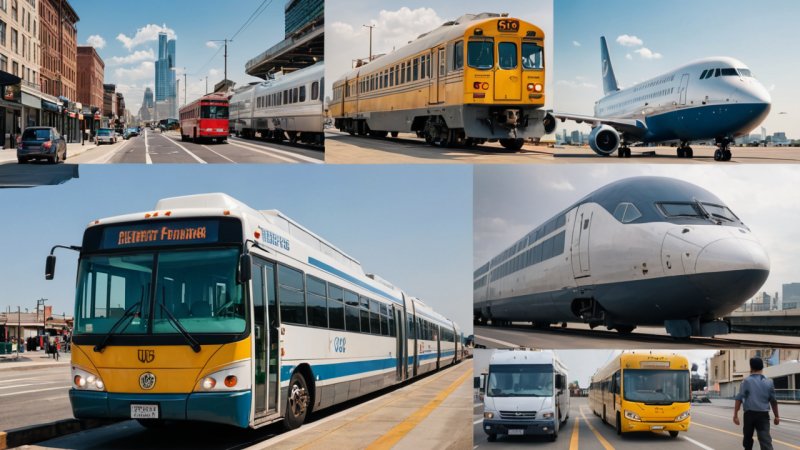Traveling is an exhilarating experience that opens up a world of adventure, culture, and connection. Whether you are jet-setting to a neighboring state or embarking on a long-haul flight across oceans, understanding the nuances of domestic and international transportation is vital for ensuring a smooth journey. Each type of travel comes with its unique set of rules, logistics, and considerations that can significantly affect your travel experience. This article delves into the key differences between domestic and international transportation, exploring their implications on travel planning, costs, regulations, and overall experience.
Types of Transportation
When we categorize transportation, we can generally divide it into two main types: domestic and international. Domestic transportation refers to travel within the same country, while international transportation involves crossing national borders. The modes of transportation available for both types can vary widely, and understanding these differences can help travelers choose the best option for their needs.
Domestic Transportation Options
In domestic travel, travelers enjoy a variety of transportation modes that are often more accessible and affordable. Here are some common options:
- Air Travel: Domestic flights are prevalent for long distances. Airlines offer various choices, from budget to premium services, making air travel a preferred option for many.
- Rail Transport: Trains can be a convenient and scenic way to explore a country. Countries like Japan, France, and the USA have extensive rail networks that connect major cities.
- Road Travel: Cars, buses, and motorcycles are popular for road trips. Domestic travel often allows for flexibility in schedule and routes, enabling travelers to explore off-the-beaten-path destinations.
- Public Transportation: Buses, trams, and subways are essential for urban travel and are often affordable and efficient for navigating cities.
International Transportation Options
International travel typically involves more complex logistics and regulations. Here are the primary modes of international transportation:
- Air Travel: International flights dominate international transportation, with airlines offering direct and connecting flights to various destinations worldwide.
- Sea Travel: Cruises and ferries serve as alternatives for international travel, providing unique experiences and the chance to visit multiple destinations in one journey.
- Land Travel: For neighboring countries, travelers may opt for buses or trains that cross borders. This can be a more immersive way to experience the journey.
Travel Regulations
One of the most significant differences between domestic and international transportation lies in the regulations governing travel. Domestic travel usually entails fewer restrictions, while international travel requires adherence to various laws and policies.
Documentation Requirements
When traveling domestically, identification such as a driver’s license or national ID is often sufficient. However, international travelers must possess a valid passport, and in many cases, a visa is required for entry into certain countries. It’s crucial to check entry requirements well in advance of travel to avoid any last-minute issues.
Security Protocols
Security measures also differ between domestic and international flights. While both types of travel require passengers to undergo screening, international flights typically have more stringent security checks due to the greater risks involved in crossing borders. Travelers should arrive at the airport earlier for international flights to allow for these additional procedures.
Cost Considerations
The costs associated with domestic and international travel can vary significantly. Domestic travel often offers more budget-friendly options, while international travel can incur higher expenses. Here are some factors to consider:
Flight Costs
Domestic flights are generally cheaper than international flights, primarily due to shorter distances and a larger number of airlines competing for business. However, international flights can also vary widely in price based on the destination, time of year, and how far in advance tickets are purchased.
Additional Fees
International travel may involve additional fees not typically encountered during domestic travel. These can include visa fees, currency exchange fees, and additional insurance costs. It’s essential to factor these expenses into your travel budget.
Travel Experience and Cultural Exposure
Travel experiences can differ markedly between domestic and international travel, particularly in terms of cultural exposure and immersion.
Domestic Travel
Domestic travel often provides opportunities to explore diverse cultures within the same country. Many nations possess a rich tapestry of regional cultures, cuisines, and traditions that can be experienced through domestic travel. For instance, traveling within the United States allows one to experience the distinct flavors of Southern cuisine, the vibrancy of New York City, and the natural beauty of the Pacific Northwest.
International Travel
On the other hand, international travel exposes travelers to entirely different customs, languages, and lifestyles. Engaging with locals, trying authentic cuisine, and participating in cultural festivals can be transformative experiences that broaden one's perspective. For example, visiting Japan offers a unique blend of modernity and tradition, while a trip to Italy immerses travelers in art, history, and culinary delights.
Summary
In conclusion, understanding the differences between domestic and international transportation is crucial for planning a successful travel experience. Domestic transportation offers a range of accessible and often more affordable options, with fewer regulations and costs. In contrast, international transportation presents unique challenges, including documentation requirements and higher costs, but also offers unparalleled opportunities for cultural immersion and exploration. As you embark on your next journey, consider these factors to make informed decisions that enhance your travel experience.






